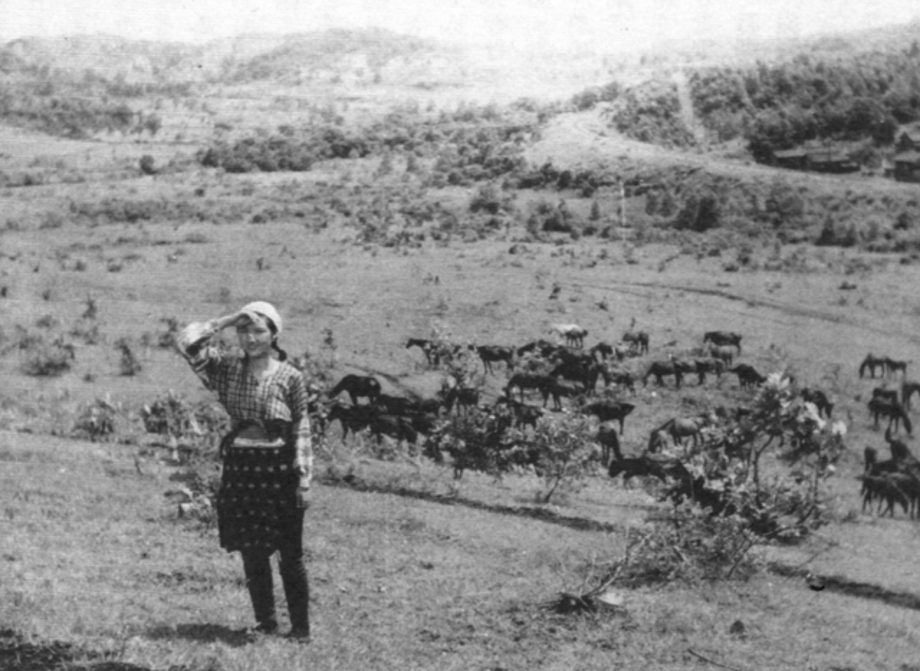
Experience in a movie theater is not about the movie itself sometimes. It is about sharing time and space with total strangers. Most of the time, you don’t know who this person is sitting in the next seat. Sometimes it’s a guy munching on popcorn, sputtering the salver-coated debris whenever he finds something funny on the screen. Sometimes it’s an old fat lady who wiggles in the seat uncomfortably whenever a sexually-explicit scene comes up. Of course, there is always a soul who just snores through whole 2 hours of matinée. But somehow we share the time and space, – and anticipation. We buy tickets to be captivated by something extraordinary. And if the movie is a silent film from 1931, directed by a lesser-known figure of Japanese cinema, screened with live piano accompaniment, you have the audience dedicated to the joy of cinematic experience.
LOVE, BE WITH HUMANITY (1931) was screened at the Jimbo-cho Theater in Kanda, Tokyo on April 27, as a part of “Golden Week of Japanese Silent Cinema”. Tickets for 90 seats were sold out a few hours before the screening. It’s a three-hour long epic produced by Shochiku, the movie studio noted for Ozu, Shimizu, and Naruse in prewar years. Categorized as “Shochiku Kamata Modernism”, this film by Yasujiro Shimazu is a prime example of amalgamation of expressionism, social realism and Hollywood melodrama. Moreover, this film presents us with the atmosphere of modern Tokyo in prewar days, Tokyo which was to lost forever.
Shochiku studio produced this film to celebrate the return of Hollywood Japanese star, Sojin Kamiyama. He was most memorable as the Mongolian Prince in Douglas Fairbanks’ THE THIEF OF BAGDAD (1924), which earned him a streak of villainous roles in various Hollywood silents. The advent of sound cinema striped him of carrier in Hollywood, since he spoke little English. He sought carrier in Japanese movie industry, with credentials as a Hollywood star. Shochiku saw the opportunity to cash in, supposedly creating the epic to match the actor with “Hollywood” fame. The film was assigned to Yasujiro Shimazu, a veteran of the Shochiku Kamata Studio, who had directed more than 100 films already. It took almost two years to complete, consumed 200,000 feet of film negatives, employed 80,000 extras in total, and listed more than 30 stars (including Mack Swain). Though renovated with modern background of capitalistic society, it is a familiar tale of KING LEAR. Koukichi (Kamiyama) is a capitalist playing the hard ball all the time, even to his sons. One of the sons Takeshi (Denmei Suzuki) does not get along with Koukichi, and becomes the black sheep of the family. Koukichi sees the big opportunity in lumber industry and buys the vast land in Sakhalin, which would reverse the course of his luck eventually ….

The film was in two parts, “Japanese Part” and “American Part”, in 14 reels and 6 reels, respectively. Even at 24 fps, it would take three hours. At Pordenone Silent Film Festivel 2010, the film was presented with piano accompaniment, and took four hours at 18fps. Jimbo-cho Theater screened it at 24 fps, with an intermission. The film is full of memorable cinematic moments. Hideko Takamine (TWENTY-FOUR EYES, FLOATING CLOUDS) was 6 years old, playing a boy, with such a poignancy I never forget. Kinuyo Tanaka (UGETSU, SANSHO THE BAILIFF) plays a street-wise dancer, who is in love with Takeshi, a guy with a heart of gold. Though her part sometimes calls for Griffith-like melodramatic overacting, she nevertheless enriched the screen with subtle expressions and natural gestures. Extensive use of location shootings both in urban areas of Tokyo and in the wild, harsh land of Sakhalin, provided the film with authentic background of the time. Though the film drags quite a bit at the beginning, the plot is fast-moving and fairly well-constructed.
Watching silent films in a suitable atmosphere is a different experience from typical movie-viewing. It requires a live music accompaniment, maybe a piano for a small theater and a larger musical unit for a larger hall. Mie Yanashita, who also supplied the piano accompaniment at Pordenone three years ago, played the piano for this small theater. At the entrance, theater staffs handed each of us a package of “snacks” for the intermission. A bottle of green tea, Daimaruyaki (Sweet bean stuffed Pancake) and Tenugui (Japanese hand towel, its design is a nice silhouette of a movie cameraman and a girl). Such a treat alone made me feel like a kid on a field trip, anticipating something wonderful to happen. I guess if every movie theater did the same thing, their box-office ticket sales would cover the cost of “snacks” and might make actual money. The audience shared the wonder, peeked into the era we never knew, and felt something resembling regret that this craft of art will never be created again.
The film’s last reel is a kind of a jaw-dropping moment. The reconciled family moved to the West (in the U.S. !) and Takeshi is now a cowhand. Mack Swain appears as a local doctor, while Soujin Kamiyama transforms himself into an old retired man, a la Lon Chaney Sr. I believe they did shoot this scene in U.S., and it looks so natural and authentic that if someone told me this were the scene from a Tom Mix Western, I would believe it. Though it may seem absurd in terms of drama ending in a totally unrelated location, it was meant to be a tribute to Kamiyama’s status in Hollywood. Cinema was an entertainment, after all. Japanese audience would love to see Kamiyama showing his skill as a man of thousand faces, Suzuki, a sturdy-built, dashing hero-type, mastering his horse in a vast land, and Kinuyo Tanaka decorated in Janet Gaynor halo. So, it was a joy to see this film end this way. I do appreciate the effort put into this presentation by staff at Jimbo-cho Theater and the pianist Mie Yanashita.
